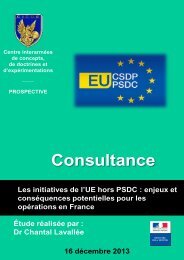Conference
science-research-bulletin-2013-conference
science-research-bulletin-2013-conference
Create successful ePaper yourself
Turn your PDF publications into a flip-book with our unique Google optimized e-Paper software.
EUROPEAN POLICE SCIENCE AND RESEARCH BULLETIN<br />
SPECIAL CONFERENCE EDITION<br />
and fewer grievances and complaints; and better<br />
relationships with the community, resulting in a<br />
more effective service and better quality services,<br />
leading to increased public confidence.<br />
In an era where the emphasis on service in policing<br />
has become paramount, evidence suggests that<br />
women may have a positive impact on shifting<br />
policing philosophy away from a crime control<br />
to a community and citizen-focused approach.<br />
Women officers demonstrate a strong ‘service<br />
oriented’ commitment to policing, emphasising<br />
communication, familiarity and the building of<br />
trust and rapport with communities (Brown and<br />
Woolfenden, 2011; Davies and Thomas, 2003;<br />
Heidensohn, 1992; Fleming & McLaughlin,<br />
2010). Miller (1999) found that women police<br />
are perceived as ‘friendly and service oriented’<br />
by members of their communities. Brown et al.<br />
(2009) present evidence to demonstrate that<br />
the members of the community recognise the<br />
value of an increased representation of women<br />
and the importance of a more diverse police<br />
service, expressing preferences for women police<br />
to deal with victims and missing persons. The<br />
Patten Report (1999) in Northern Ireland has<br />
also emphasised the positive effect of having a<br />
much higher proportion of women officers on<br />
enhancing the effectiveness of policing within<br />
the community.<br />
In relation to their enactment of everyday practices,<br />
specifically, interacting with and apprehending<br />
potential or actual perpetrators of crime, research<br />
shows that, when compared to men, women<br />
police appear to be less ‘trigger happy’ and much<br />
less likely use deadly force (Brown and Langan,<br />
2001; McElvain and Kposowa, 2008; Waugh et<br />
al, 1998), utilise threats, physical restraint, force<br />
and arrest (Rabe- Hemp, 2008; Shuck & Rabe-<br />
Hemp, 2005). In a study of conflict management,<br />
Braithwaite & Brewer (1998) found that male<br />
officers were twice as likely as female officers to<br />
engage in threatening behaviour and physical<br />
contact with members of the public, which in<br />
turn elicited greater resistance and aggression.<br />
Such findings appear to provide explanations for<br />
evidence which demonstrates that women are less<br />
likely to abuse their power and attract complaints<br />
and allegations of misconduct (Brereton, 1999;<br />
Corsianos, 2011; Lonsway, Wood and Spillar,<br />
2002). Waugh et al. (1998) found that male police<br />
attracted two and a half times as many allegations<br />
of assault as female police. Moreover, successive<br />
inquiries into corruption and police misconduct<br />
in Australia have concluded that there is a direct<br />
association between increasing the number of<br />
women police officers and reducing levels of<br />
corruption (Fleming & Lafferty, 2003).<br />
Positive outcomes in relation to policewomen’s<br />
enactments of police practices can also be found<br />
in relation to their interactions with victims of<br />
crime, particularly those that have experienced<br />
sexual offences and domestic violence. Research<br />
by Brown and King (1998); Page (2007) and<br />
Schuller and Stewart (2000) found that women<br />
police officers are more likely to believe victims,<br />
attribute less blame to the victim and be<br />
less accepting of rape myths than their male<br />
counterparts. Research by Rabe-Hemp (2008,<br />
2009) also suggests that women officers bring<br />
a high level of empathy in serving the needs of<br />
women and children, especially those that have<br />
been subject to violent or sexual abuse. Using<br />
data collected by a large scale observational<br />
project on the impact of officer gender on police<br />
response to domestic violence, Sun (2007) found<br />
that whilst there was no significant difference<br />
between female and male officers in their<br />
exercise of control actions towards citizens, there<br />
is some evidence to support the link between<br />
officer gender and non-coercive actions. Such<br />
findings are echoed in a recent review of global<br />
policing which has emphasised the positive<br />
effects of women for police conduct and policecommunity<br />
interactions, in the management and<br />
de-escalation of conflict situations and in the<br />
support for victims of crime (Brown et al., 2014).<br />
The extent to which the call for more women<br />
police stems from an appreciation of the benefits<br />
outlined above remains a contested point. More<br />
cynically perhaps, the call for more women might<br />
be better understood as an attempt to re-balance<br />
a loss in police legitimacy in times of crisis.<br />
Plagued by a series of high profile events and<br />
chief officer resignations in England and Wales,<br />
the past decade has witnessed a growing disquiet<br />
over the failures of police leaders and of the need<br />
to transform and diversify the police workforce,<br />
particularly those working in leadership (Condon,<br />
1997; HMIC, 1996; HMIC, 1999). The race to<br />
appoint a new London Metropolitan Police<br />
Commissioner in September 2011 serves as a<br />
good example here. In July 2011, Conservative<br />
Prime Minister David Cameron, told the House<br />
of Commons that the system for producing<br />
police leaders was ‘too closed’, and that ‘There<br />
are too few, and arguably too similar, candidates<br />
applying for the top jobs’. Following widespread<br />
media speculation over who might succeed Sir<br />
146





